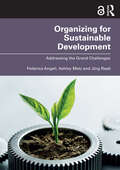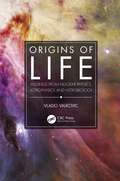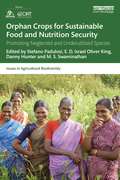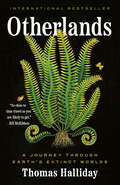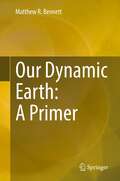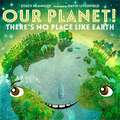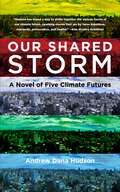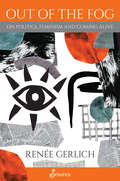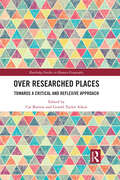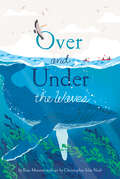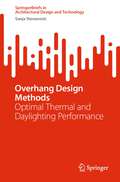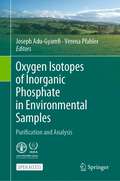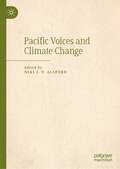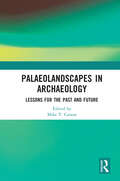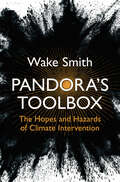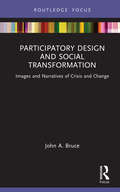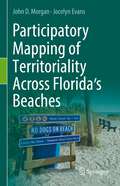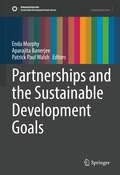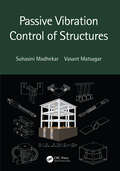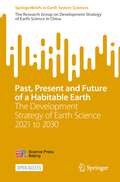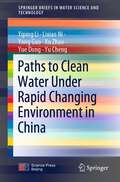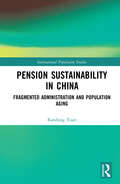- Table View
- List View
Organizing for Sustainable Development: Addressing the Grand Challenges
by Federica Angeli Ashley Metz Jörg RaabThe Sustainable Development Goals (SDGs) recognize the increasingly complex, interdependent nature of societal and environmental issues for governments and business. Tackling such "grand challenges" requires the concerted action of a multitude of organizations and multiple stakeholders at different levels in the public, private, and non-profit sector.Organizing for Sustainable Development provides an integrated and comparative overview of the successes and failures of organizational efforts to tackle global societal issues and achieve sustainable development. Summarizing years of study by an interdisciplinary board of authors and contributors, this book provides readers with an in-depth understanding of how existing businesses and new hybrid organizations can achieve sustainable development to bring about an improved society, marking a key contribution to the literature in this field.Combining theoretical views with empirical approaches, the chapters in this book are highly relevant to graduate and undergraduate (multidisciplinary) programs in sustainable development, organization studies, development economics, development studies, international management, and social entrepreneurship.The Open Access version of this book, available at www.taylorfrancis.com, has been made available under a Creative Commons Attribution-NonCommercial (CC-BY) 4.0 license.
Origins of Life: Musings from Nuclear Physics, Astrophysics and Astrobiology
by Vlado ValkovicThe primary purpose of this book is to prepare the ground for coordinated efforts aiming to answer the question: where and when life originated. The appearance of life involves three successive stages: i) the formation of chemical elements and their combination to simple molecules, which is the concern of physicists; ii) the evolution of organized complexity in biomolecules and their reactions, which falls within the field of chemistry; iii) the onset of Darwinian evolution after the appearance of the first cell-like structure, which is studied by biologists. This book focuses on the first two steps of this process with chapters exploring topics such as chemical element abundances; galaxies, galactic magnetic fields and cosmic rays; galactic chemical evolution. Key Features: Contains extensive lists of reference and additional reading. Includes new hypotheses concerning the origin of life. Combines consideration from nuclear physics, astrophysics, astro- and geochemistry. Despite its interdisciplinary nature, this book remains accessible to nonexperts, and would be a valuable companion for both experts and laypeople.
Orphan Crops for Sustainable Food and Nutrition Security: Promoting Neglected and Underutilized Species (Issues in Agricultural Biodiversity)
by Danny Hunter Stefano Padulosi E.D. Israel Oliver King M. S. SwaminathanOrphan Crops for Sustainable Food and Nutrition Security discusses the issues, challenges, needs and opportunities related to the promotion of orphan crops, known also as neglected and underutilized species (NUS). The book is structured into six parts, covering the following themes: introduction to NUS, approaches, methods and tools for the use enhancement of NUS, integrated conservation and use of minor millets, nutritional and food security roles of minor millets, stakeholders and global champions, and, building an enabling environment. Presenting a number of case studies at the regional and country levels, the chapters cover different but highly interlinked aspects along the value chains, from acquisition and characterization of genetic diversity, cultivation and harvesting to value addition, marketing, consumption and policy for mainstreaming. Cross-cutting issues like gender, capacity building and empowerment of vulnerable groups are also addressed by authors. Representatives from communities, research for development agencies and the private sector also share their reflections on the needs for the use enhancement of NUS from their own perspectives. This book will be of great interest to students and scholars of food security, sustainable agriculture, nutrition and health and development, as well as practitioners and policymakers involved in building more resilient food and production systems.
Otherlands: A Journey Through Earth's Extinct Worlds
by Thomas HallidayThe past is past, but it does leave clues, and Thomas Halliday has used cutting-edge science to decipher them more completely than ever before. In Otherlands, Halliday makes sixteen fossil sites burst to life on the page. <p><p> This book is an exploration of the Earth as it used to exist, the changes that have occurred during its history, and the ways that life has found to adapt―or not. It takes us from the savannahs of Pliocene Kenya to watch a python chase a group of australopithecines into an acacia tree; to a cliff overlooking the salt pans of the empty basin of what will be the Mediterranean Sea just as water from the Miocene Atlantic Ocean spills in; into the tropical forests of Eocene Antarctica; and under the shallow pools of Ediacaran Australia, where we glimpse the first microbial life. <p><p> Otherlands also offers us a vast perspective on the current state of the planet. The thought that something as vast as the Great Barrier Reef, for example, with all its vibrant diversity, might one day soon be gone sounds improbable. But the fossil record shows us that this sort of wholesale change is not only possible but has repeatedly happened throughout Earth history. Even as he operates on this broad canvas, Halliday brings us up close to the intricate relationships that defined these lost worlds. <p><p> In novelistic prose that belies the breadth of his research, he illustrates how ecosystems are formed; how species die out and are replaced; and how species migrate, adapt, and collaborate. It is a breathtaking achievement: a surprisingly emotional narrative about the persistence of life, the fragility of seemingly permanent ecosystems, and the scope of deep time, all of which have something to tell us about our current crisis.
Our Dynamic Earth: A Primer
by Matthew R. BennettStudents taking undergraduate degrees in geography, ecology, earth science, and environmental science frequently take an introductory unit in Physical Geography. Some will have not done any geography since their early teens, while others have more recent knowledge. This range of backgrounds can be challenging for both the instructor and the student, this primer aims to help. A primer is a readable introduction to a subject, more technical than a piece of popular science, but less detailed than a specialist textbook. It aims to give the reader a platform in a subject with which they may be unfamiliar, so that they can proceed simultaneously, or sequentially, to more advanced texts and information. Ideally the primer should have something for those without any knowledge, while also challenge and entertaining those who do. Not quite bedtime reading, but a step in that direction. Our Dynamic Earth introduces students to the Earth's origins, to plate tectonics, atmospheric and oceanographic circulation, as well as to a range of Earth surface processes. Idea to get you started in your studies.
Our Planet! There's No Place Like Earth (Our Universe #6)
by Stacy McAnultyFrom writer Stacy McAnulty and illustrator David Litchfield, Our Planet! There's No Place Like Earth is a nonfiction picture book about the Earth, told from the perspective of Earth herself.Meet Earth. Planet Awesome! And your awesome home! Actually, Earth is home to all the plants and all the animals in the solar system, including nearly eight billion people. Humans have accidentally moved Earth's climate change into the fast lane, and she need your help to put on the brakes. Earthlings need Earth, and Earth needs Earthlings, so let’s save Earth together!With characteristic humor and charm, Stacy McAnulty channels the voice of Earth in this next celestial "autobiography" in the Our Universe series. Rich with kid-friendly facts and beautifully brought to life by David Litchfield, this is an equally charming and irresistible picture book.
Our Shared Storm: A Novel of Five Climate Futures
by Andrew Dana HudsonThrough speculative fiction, five interlocking novelettes explore the possible realities of our climate future.What is the future of our climate? Given that our summers now regularly feature Arctic heat waves and wildfire blood skies, polar vortex winters that reach all the way down to Texas, and “100-year” storms that hit every few months, it may seem that catastrophe is a done deal. As grim as things are, however, we still have options. Combining fiction and nonfiction and employing speculative tools for scholarly purposes, Our Shared Storm explores not just one potential climate future but five possible outcomes dependent upon our actions today. Written by speculative-fiction writer and sustainability researcher Andrew Dana Hudson, Our Shared Storm features five overlapping fictions to employ a futurist technique called “scenarios thinking.” Rather than try to predict how history will unfold—picking one out of many unpredictable and contingent branching paths—it instead creates a set of futures that represent major trends or counterposed possibilities, based on a set of climate-modeling scenarios known as the Shared Socioeconomic Pathways (SSPs).The setting is the year 2054, during the Conference of the Parties global climate negotiations (a.k.a., The COP) in Buenos Aires, Argentina. Each story features a common cast of characters, but with events unfolding differently for them—and human society—in each alternate universe. These five scenarios highlight the political, economic, and cultural possibilities of futures where investments in climate adaptation and mitigation promised today have been successfully completed, kicked down the road, or abandoned altogether. From harrowing to hopeful, these stories highlight the choices we must make to stabilize the planet.Our Shared Storm is an experiment in deploying practice-based research methods to explore the opportunities and challenges of using climate fiction to engage scientific and academic frameworks.
Out of the Fog: On Politics, Feminism and Coming Alive
by Renée Gerlich...understanding how our private heartbreak relates to our large-scale problems is the only way we can unravel the helplessness we feel, claim our voices, and take action in the way we deeply crave. We cannot do any of these things while living with the cognitive dissonance of competing ideas, priorities, solutions, and top-down paternalism.From racialised police brutality to climate change, #MeToo, ‘ trans rights' , COVID-19, the prospect of nuclear war and the prevalence of trauma – we are constantly bombarded with high stakes problems that we are expected to speak out about and act on. On closer inspection, the popular solutions to each of these problems aren' t easy to reconcile. Black Lives Matter activists demand prison abolition, while #MeToo feminists want rapists in jail – and while our objections to war and police brutality make us suspicious of state institutions in general, our responses to climate change and COVID-19 reinforce our dependency on them.Out of the Fog cuts through the confusion. René e Gerlich suggests that readers move beyond feeling overwhelmed and emotionally manipulated. She draws on a radical feminist tradition that demonstrates how our despair is connected to our most pressing social problems, and offers a framework for assessing and interpreting the current political landscape. Out of the Fog delivers clarity and guidance in this bewildering time. René e Gerlich' s insights will help you develop the capacity to speak with an authentic voice and to act purposefully and with impact in the world.
Over Researched Places: Towards a Critical and Reflexive Approach (Routledge Studies in Human Geography)
by Cat Button Gerald Taylor AikenThe book explores the implications that research-density has on the people and places researched, on the researchers, on the data collected and knowledge produced, and on the theories that are developed. It examines the effects that research-density has on the people and places researched, on the researchers, on the data collected and knowledge produced, and on the theories that are developed. By weaving together experiences from a variety of countries and across disciplinary boundaries and research methods, the volume outlines the roots of over-research, where it comes from and what can be done about it. The book will be useful for social science students and researchers working in ethnographic disciplines such as Human Geography, Anthropology, Urban Planning, and Sociology and seeking to navigate the tricky ‘absent present’ of already existing research on their fields of exploration.
Over and Under the Waves (Over and Under)
by Kate MessnerExplore the wonders and beauties of the ocean's kelp forests in this latest addition to the acclaimed Over and Under series. Award-winning duo Kate Messner and Christopher Silas Neal return in this latest addition to the Over and Under picture book series, this time exploring the rich, interconnected ecosystem of the ocean! Over the waves, the sea lions bark and seagulls wheel and call. The bay is smooth and bright in the sun. But under the waves, there's a whole hidden forest, full of whales and wolf eels, sardines and sea bass, leopard sharks and luminous jellies, as well as the waving kelp that shelters them all. Discover the magical depths of the kelp forest, and all the fascinating creatures living just a paddle's length away—over and under the waves. SO MANY FASCINATING FACTS: Kids are endlessly curious about the natural world and the wildly varied animals and plants living in it—and the ocean is FULL of amazing and surprising life! ENVIRONMENTAL AWARENESS MADE WONDERFUL: Preservation of our wilderness—and of our oceans in particular—is essential, and this book makes such a great, upbeat jumping-off point for discussions of the importance and wonder of our world's natural habitats and ecosystems. THE GORGEOUS UNDERWATER WORLD: This new book in the Over and Under series illuminates the magic and amazing biodiversity of the kelp forest by telling the story of one family's kayaking trip through a real-world ocean ecosystem. Lyrical prose and color-drenched illustrations will draw even the most reluctant readers into the world. STRONG CURRICULUM CONNECTIONS: The Next Generation Science Standards (NGSS) emphasize learning about animal habitats/biomes in K-2 curriculums, while later grades address topics like food chains, conservation, and endangered species. With a depth of research and an engaging, highly visual narrative, this book is an excellent resource for librarians and primary school educators. FROM A FAVORITE AUTHOR-ILLUSTRATOR TEAM: Kate Messner and Chris Neal make nonfiction approachable and appealing! These two award-winning creators have received countless accolades and published books to critical acclaim, making them the perfect team to tackle any nonfiction topic. Perfect for:Those who loved Over and Under the Snow and other books in the Over and Under seriesFans of Kate MessnerLovers of the ocean and marine lifeParents and grandparents seeking beautiful books to read aloud togetherTeachers, educators, and librarians seeking illustrated nonfiction books with STEM contentAnyone seeking a distinctive gift for a child who loves animals or nature
Overhang Design Methods: Optimal Thermal and Daylighting Performance (SpringerBriefs in Architectural Design and Technology)
by Sanja StevanovicIt is estimated that windows in office buildings are responsible for one third of energy used for their heating and cooling. Designing window shading that balances often contradictory goals of preventing excessive heat gains in hot periods, without compromising beneficial heat gains in cold periods or visual comfort in indoor spaces of modern buildings with highly glazed facades, is an interesting multi-objective optimisation problem that represents an active research topic in the field of building energy and daylighting. Window overhangs are the simplest and most traditional shading devices that are easy to install, highly cost-effective, require low or no maintenance and offer unobstructed views outside. This book provides a review of overhang design methods for optimal thermal and daylighting performance. It starts with a historical overview of methods based on solar positions and shading masks. Next it discusses current research methodology, including shading calculation methods, ways of quantifying thermal and daylighting overhang effectiveness and the use of multi-objective optimisation approaches, together with the case studies that employ them. It further covers methods for designing innovative overhang types such as NURBS outlined overhangs and PV integrated dynamic overhangs. The appendix classifies published overhang case studies according to major climate type and latitude of their locations. As such, the book presents a valuable resource for understanding subtle nuances of interaction between solar radiation, shading devices and indoor comfort. The intended target audience are building energy researchers interested in optimisation of window shading devices.
Oxygen Isotopes of Inorganic Phosphate in Environmental Samples: Purification and Analysis
by Joseph Adu-Gyamfi Verena PfahlerThis open access book distinguished itself from other publications by offering step-by-step instructions on how to extract, purify, provide modifications, and major issues to be encountered during the process. For the δ18OP method to progress, further fundamental research as well as field and laboratory studies need to be conducted for a better understanding of P cycling in the environment. Chapter 1 outlines the background and examples of δ18Op studies in sediments, soils, fresh water, mineral fertilizers, and plants. Chapters 2 and 3 examine the stepwise extraction and purification protocols including reagents, equipment and consumables and preparations for analyses. Chapter 4 examines some of the challenges and modifications during the purification process. Chapter 5 discusses planning and designing of a study using δ18Op, external quality assurance with an example of an inter-laboratory study. Chapter 6 outlines the conclusions, future trends, and opportunities, the scaling out of the method from laboratory to field studies. It is expected that the δ18OP would be extensively applied in research geared to understand phosphorus dynamics in different agro-environments.
Pacific Voices and Climate Change
by Niki J. P. AlsfordThis book provides a comprehensive overview of issues related to climate change in the Pacific and will be an invaluable reference for those working in this important field. Climate change represents humanity’s greatest threat. The vastness of the Pacific means that no two experiences are the same. This edited volume identifies research that highlights the local impact of climate change on the islands and coastlines of the Pacific. The authors use current research to document climate change via contextually informed studies that engages with local cultures, histories, knowledges, and communities. The transdisciplinary nature and the combination of both academic and non-academic writing makes this book an accessible and important contribution to the field.
Palaeolandscapes in Archaeology: Lessons for the Past and Future
by Mike T. CarsonWhat can we learn about the ancient landscapes of our world, and how can those lessons improve our future in the landscapes that we all inhabit? Those questions are addressed in this book, through a practical framework of concepts and methods, combined with detailed case studies around the world. The chapters explore the range of physical and social attributes that have shaped and re-shaped our landscapes through time. International authors contributed the latest results of investigating ancient landscapes (or "palaeolandscapes") in diverse settings of tropical forests, deserts, river deltas, remote islands, coastal zones, and continental interiors. The case studies embrace a broadly accommodating approach of combining archaeological evidence with other avenues of research in earth sciences, biology, and social relations. Individually and in concert, the chapters offer new perspectives on what the world’s palaeolandscapes looked like, how people lived in these places, and how communities have engaged with long-term change in their natural and cultural environments through successive centuries and millennia. The lessons are paramount for building responsible strategies and policies today and into the future, noting that many of these issues from the past have gained more urgency today. This book reaches across archaeology, ecology, geography, and other studies of human-environment relations that will appeal to general readers. Specialists and students in these fields will find extra value in the primary datasets and in the new ideas and perspectives. Furthermore, this book provides unique examples from the past, toward understanding the workings of sustainable landscape systems.
Pandora's Toolbox: The Hopes and Hazards of Climate Intervention
by Wake SmithReaching net zero emissions will not be the end of the climate struggle, but only the end of the beginning. For centuries thereafter, temperatures will remain elevated; climate damages will continue to accrue and sea levels will continue to rise. Even the urgent and utterly essential task of reaching net zero cannot be achieved rapidly by emissions reductions alone. To hasten net zero and minimize climate damages thereafter, we will also need massive carbon removal and storage. We may even need to reduce incoming solar radiation in order to lower unacceptably high temperatures. Such unproven and potentially risky climate interventions raise mind-blowing questions of governance and ethics. Pandora's Toolbox offers readers an accessible and authoritative introduction to both the hopes and hazards of some of humanity's most controversial technologies, which may nevertheless provide the key to saving our world.
Parisar Adyayan Bhag-1 class 4 - Maharashtra Board: परिसर अध्ययन भाग-१ ४थीं कक्षा - महाराष्ट्र बोर्ड
by Maharashtra Rajya Pathyapustak Nirmiti Va Abhysakram Sanshodhan Mandal Pune"परिसर अध्ययन (भाग 1)" महाराष्ट्र राज्य पाठ्यपुस्तक मंडल द्वारा प्रकाशित चौथी कक्षा के लिए एक महत्वपूर्ण पाठ्यपुस्तक है। यह पुस्तक विद्यार्थियों को उनके प्राकृतिक, सामाजिक, और सांस्कृतिक परिवेश को समझने में मदद करती है। इसमें प्राणियों, पौधों, जल, हवा, मानचित्र, परिवहन, संचार, प्राकृतिक आपदाएँ और सामूहिक जीवन जैसे विषयों को सरल और रोचक भाषा में प्रस्तुत किया गया है। पुस्तक का उद्देश्य बच्चों में पर्यावरणीय जागरूकता बढ़ाना, सामूहिक उत्तरदायित्व सिखाना और जीवन कौशल विकसित करना है। इसके अध्याय गतिविधियों, स्वाध्याय और रोचक चित्रों से भरे हैं, जो बच्चों की कल्पनाशक्ति और रचनात्मकता को प्रेरित करते हैं। यह पुस्तक बच्चों को पर्यावरण का सम्मान करना, संसाधनों का उपयोग सही तरीके से करना, और वैज्ञानिक दृष्टिकोण अपनाने के लिए प्रेरित करती है। यह बच्चों के व्यवहार, ज्ञान और सोचने की क्षमता को सुधारने में मददगार है।
Parisar Adyayan Bhag-1 class 5 - Maharashtra Board: परिसर अध्ययन भाग-१ ५वीं कक्षा - महाराष्ट्र बोर्ड
by Maharashtra Rajya Pathyapustak Nirmiti Va Abhysakram Sanshodhan Mandal Pune"परिसर अध्ययन भाग 1" महाराष्ट्र बोर्ड की कक्षा 5 की हिंदी पाठ्यपुस्तक है, जो प्राकृतिक, सामाजिक और सांस्कृतिक परिवेश की जानकारी प्रदान करती है। इसमें छात्रों को पृथ्वी, पर्यावरण, मानचित्र, नागरिक शास्त्र, परिवार, सार्वजनिक सुविधाएँ, जल स्रोत, खाद्य सुरक्षा, संचार, परिवहन, स्वास्थ्य और समुदाय से जुड़ी मूलभूत अवधारणाएँ सिखाई जाती हैं। पुस्तक में वैज्ञानिक दृष्टिकोण विकसित करने पर बल दिया गया है और छात्र गतिविधियों के माध्यम से व्यावहारिक ज्ञान प्राप्त कर सकते हैं। इसमें चित्र, मानचित्र, प्रश्नोत्तर, और व्यावहारिक गतिविधियाँ शामिल हैं, जो छात्रों को अपने आसपास के वातावरण को समझने और उसमें सुधार करने के लिए प्रेरित करती हैं। इस पाठ्यपुस्तक का उद्देश्य बच्चों को आत्मनिर्भर और जागरूक नागरिक बनाना है, जो समाज और पर्यावरण के प्रति उत्तरदायी हों।
Participatory Design and Social Transformation: Images and Narratives of Crisis and Change (Routledge Focus on Environment and Sustainability)
by John A. BruceParticipatory Design and Social Transformation introduces theories and methodologies for using image-oriented narratives as modes of inquiry and proposition toward greater justice and equity for society and the environment. Participatory artistic- and design-based research encounters – being, making, and learning with people, things, and situations – are explored through practices that utilize image-oriented and cinematic narratives. Collaborative alliances are invited to consider aesthetics, visuality, attunement, reflection, reciprocity, and care as a means for transdisciplinary approaches that foster generative and ethically responsible conditions toward collective liberation. The design of spectacles is proposed as a way for collective movements to affectively contribute to positive systemic changes from the ground up. In this way, Participatory Design and Social Transformation bridges contemporary advances in design theory and practice with media and art theory, the human and social sciences, and a pedagogy of interdependence. Participatory Design and Social Transformation will be of great interest to both professional and academic communities, providing resources for researchers, artists, designers, activists, students, educators, and leaders engaged with initiatives for transformation.
Participatory Mapping of Territoriality Across Florida’s Beaches
by John D. Morgan Jocelyn EvansThis book offers a theoretical and practical exploration of the beach as space and places unique disciplinary lenses (Political Science and Geography). If we accept that what one possesses, one has a claim to, becoming property, then how that possession is enforced, socially, makes all the difference in defining what constitutes territoriality. Morgan and his colleagues have carried out various studies and applied various methods to study the developing coast of Florida. From these efforts, we compare the different regions of the State (e.g., Florida panhandle vs. South Florida) in terms of local beach culture and economics to unpack the topic of tension between beach property and access using firsthand accounts in many cases. This book approaches the complex topic of territoriality on Florida’s beaches from multiple perspectives but related methods involving time geography, a public space index, participatory mapping/cartography, and transboundary viewsheds. This analysis illustrates the fruitfulness of conceptualizations of property that are complex, multiplicative, and evolving. It calls for a recognition of human rights to the commons -- both now and in the future. And it highlights the constructed nature of public space - as a space that provides meaning through bodily performance and encounter. Approaches the complex topic of territoriality on Florida’s beaches from methods of participatory mapping/cartography and performance art.Offers a theoretical and practical exploration of the beach as space and place.Utilizes the lens of territoriality and field-based participant cartographic mapping to understand better how the developed shoreline is territorialized.
Partnerships and the Sustainable Development Goals (Sustainable Development Goals Series)
by Enda Murphy Aparajita Banerjee Patrick Paul WalshThis volume fills a significant gap in the scientific and policy literature on the Sustainable Development Goals (SDGs) and on SDG 17 which focuses on partnership as a means of implementation (MOI) for the SDGs. The collection offers a strong theoretical context, and outlines the nature of partnerships (e.g. alternative forms, multi-level forms, barriers to take-up) using the most recent UN database as well as through key case studies that highlight partnership successes and failures at local, national and global scales. The text covers a brief history and background of partnerships and the SDGs, an analysis of existing SDG partnership using UN data, a scalar analysis of case studies involving multi-stakeholder partnerships, and recommendations for successful partnership models and implementation strategies. The book will be relevant for a wide variety of readerships including academics in different policy fields and disciplines, policymakers, SDG advocates and practitioners, and NGOs active in the promotion of the SDGs and environmental issues. Provides a unique outline of partnership theory and its application to the SDGs Outlines the nature of partnerships, including their multi-level forms and barriers to take-up using UN data Analyzes key SDG partnerships case studies that highlight partnership success stories for practitioners
Passive Vibration Control of Structures
by Suhasini Madhekar Vasant MatsagarResearch in vibration response control deals not only with prevention of catastrophic failures of structures during natural or accidental/manmade hazards but also ensures the comfort of occupants through serviceability. Therefore, the focus of this book is on the theory of dynamic response control of structures by using different kinds of passive vibration control devices. The strategies used for controlling displacement, velocity, and acceleration response of structures such as buildings, bridges, and liquid storage tanks under the action of dynamic loads emanating from earthquake, wind, wave, and so forth are detailed. The book: Explains fundamentals of vibration response control devices and their practical applications in response mitigation of structures exposed to earthquake, wind, and wave loading Offers a comprehensive overview of each passive damper, its functioning, and mathematical modeling in a dynamical system Covers practical aspects of employing the passive control devices to some of the benchmark problems that are developed from existing buildings and bridges in different countries worldwide Includes MATLAB® codes for determining the dynamic response of single degree of freedom (SDOF) and multi-degree of freedom (MDOF) systems along with computational models of the passive control devices This book is aimed at senior undergraduate students, graduate students, and researchers in civil, earthquake, aerospace, automotive, mechanical engineering, engineering dynamics, and vibration control, including structural engineers, architects, designers, manufacturers, and other professionals.
Past, Present and Future of a Habitable Earth: The Development Strategy of Earth Science 2021 to 2030 (SpringerBriefs in Earth System Sciences)
by Res. Group Dev Strategy of Earth ScienceThis perspective of this book views Earth's various layers as a whole system, and tries to understand how to achieve harmony and sustainable development between human society and nature, with the theme of " habitability of the Earth." This book is one effort at providing an overview of some of the recent exciting advances Chinese geoscientists have made. It is the concerted team effort of a group of researchers from diverse backgrounds to generalize their vision for Earth science in the next 10 years. The book is intended for scholars, administrators of the Science and Technology policy department, and science research funding agencies. This is an open access book.
Paths to Clean Water Under Rapid Changing Environment in China (SpringerBriefs in Water Science and Technology)
by Yu Cheng Yue Dong Yiping Li Xu Zhao Lixiao Ni Yong GuoThis book mainly provides the current status of water pollution faced by China under rapid changing environment and the actions that have been taken for prevention and treatment of water pollution. It points out that the water pollution situation is severe. Facing water pollution, China’s experiences include several aspects on source control and pollution interception, internal nutrient removal of sediment, ecological restoration, and water transfer policy. There exists both the opportunity and challenge for the prevention and control of water pollution in China. The book contains numerous charts and diagrams which further illustrating China’s paths to clean water.
Peculiar Primates: Fun Facts About These Curious Creatures
by Debra Kempf ShumakerFrom flossing and howling, to building nests and thumping chests, this delightful follow up to Freaky, Funky Fish explores the amazing things primates do. All primates climb and breathe in air. They have big brains and hands and hair. But. . . some live alone, some live in groups. One primate has a nose that droops. Peculiar Primates is an adorable picture book with a scientific—and child-friendly—underpinning. With examples of different primates for each description, as well as extensive backmatter explaining the fascinating science behind their behaviors, this bizarre book captures the wonders of our ecosystem.
Pension Sustainability in China: Fragmented Administration and Population Aging (International Population Studies)
by Randong YuanPension Sustainability in China: Fragmented Administration and Population Aging aims to investigate the impact of fragmentation and population ageing on pension sustainability in China. The book demonstrates how pension sustainability is compromised by various adverse effects produced by fragmentation, such as the moral hazard caused by the disarticulated intergovernmental fiscal responsibility. An overlapping generations (OLG) model is updated with the latest demographic data and is used to assess the impact of population ageing on pension sustainability. The book considers whether adjustment in retirement age can ensure long-term financial sustainability. It explores how, compared to the population ageing, the issues stemming from the fragmentation pose a more insidious threat to pension sustainability in China.
